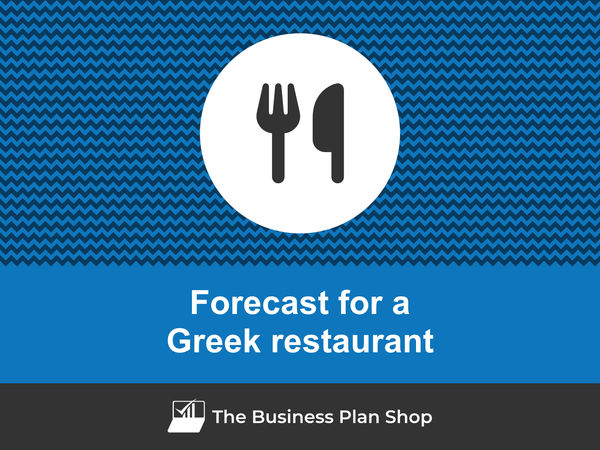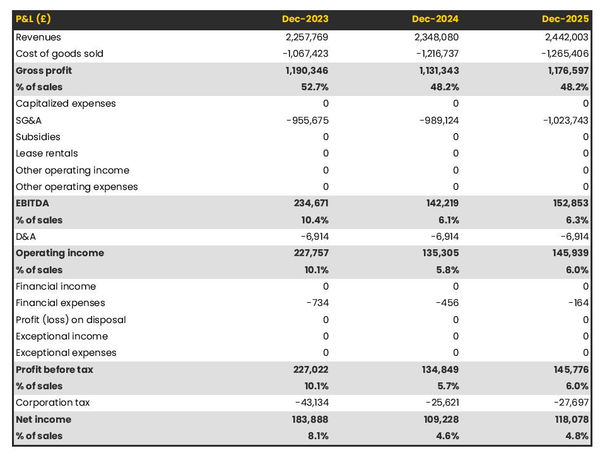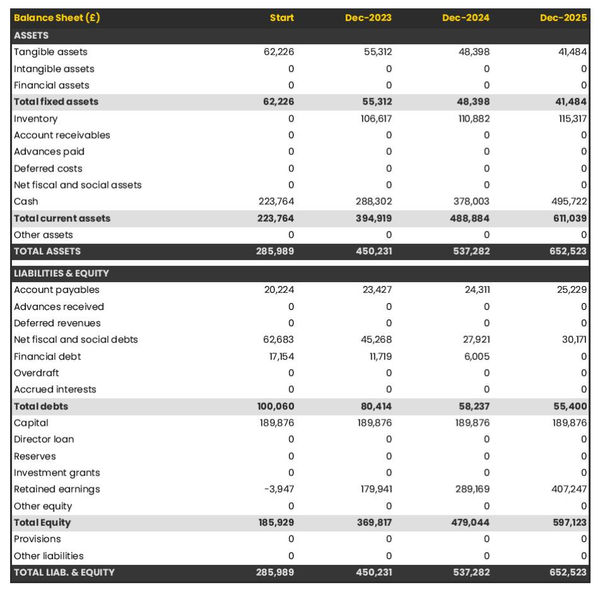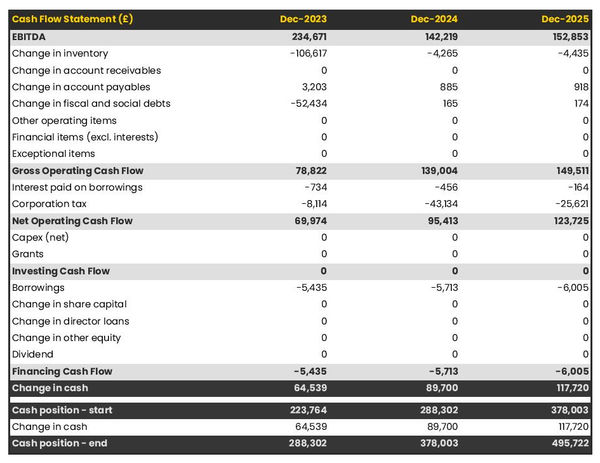How to create a financial forecast for a Greek restaurant?

Creating a financial forecast for your Greek restaurant, and ensuring it stays up to date, is the only way to maintain visibility on future cash flows.
This might sound complex, but with the right guidance and tools, creating an accurate financial forecast for your Greek restaurant is not that hard.
In this guide, we'll cover everything from the main goal of a financial projection, the data you need as input, to the tables that compose it, and the tools that can help you build a forecast efficiently.
Without further ado, let us begin!
Why create and maintain a financial forecast for a Greek restaurant?
The financial projections for your Greek restaurant act as a financial blueprint to guide its growth with confidence and ensure its long-term financial viability.
To create them, you will need to look at your business in detail - from sales to operating costs and investments - to assess how much profit it can generate in the years to come and what will be the associated cash flows.
During challenging market conditions, maintaining an up-to-date financial forecast enables early detection of potential financial shortfalls, allowing for timely adjustments or securing financing before facing a cash crisis.
Your Greek restaurant's financial forecast will also prove invaluable when seeking financing. Banks and investors will undoubtedly request a thorough examination of your financial figures, making precision and presentation essential.
Need a solid financial forecast?
The Business Plan Shop does the maths for you. Simply enter your revenues, costs and investments. Click save and our online tool builds a three-way forecast for you instantly.

What information is used as input to build a Greek restaurant financial forecast?
A Greek restaurant's financial forecast needs to be built on the right foundation: your assumptions.
The data required to create your assumptions will depend on whether you are a new or existing Greek restaurant.
If you are creating (or updating) the forecast of an existing Greek restaurant, then your main inputs will be historical accounting data and operating metrics, and your team’s view on what to expect for the next three to five years.
If you are building financial projections for a new Greek restaurant startup, you will need to rely on market research to form your go-to-market strategy and derive your sales forecast.
For a new venture, you will also need an itemised list of resources needed for the Greek restaurant to operate, along with a list of equipment required to launch the venture (more on that below).
Now that you understand what is needed, let’s have a look at what elements will make up your Greek restaurant's financial forecast.
The sales forecast for a Greek restaurant
From experience, it usually makes sense to start your Greek restaurant's financial projection with the revenues forecast.
The inputs used to forecast your sales will include the historical trading data of your Greek restaurant (which can be used as a starting point for existing businesses) and the data collected in your market research (which both new ventures and existing businesses need to project their sales forward).
Your Greek restaurant's sales forecast can be broken down into two key estimates:
- The average price
- The number of monthly transactions
To assess these variables accurately, you will need to consider the following factors:
- Menu Offerings: The types of dishes and ingredients offered on your menu can greatly impact your average price and number of transactions. For example, including high-end ingredients such as imported feta cheese or fresh seafood can increase your average price, while offering a variety of vegetarian options can attract more customers and increase the number of transactions.
- Seasonal Variations: As a Greek restaurant, your menu may be impacted by seasonal variations in the availability of certain ingredients. For example, during the summer months, fresh Mediterranean produce may be more readily available, allowing you to offer more seasonal specials and potentially increase your average price.
- Customer Demographics: The demographics of your customer base can also affect your average price and number of transactions. For instance, if your restaurant is located in a predominantly tourist area, you may see a higher number of transactions during peak tourist season, but these customers may be more price-sensitive and may not be willing to pay a high average price.
- Competition: The presence of other Greek restaurants in your area can also impact your average price and number of transactions. If there are many competitors offering similar dishes and prices, you may need to adjust your prices or menu offerings in order to remain competitive and attract customers.
- Events and Holidays: Special events and holidays, such as Greek festivals or holidays, can also affect your sales forecast. These events may bring in a higher number of customers, but may also require additional expenses for decorations or special menu items. Planning for these events can help you better predict your average price and number of transactions in the coming years.
Once you have a sales forecast in place, the next step will be to work on your overhead budget. Let’s have a look at that now.
Need inspiration for your business plan?
The Business Plan Shop has dozens of business plan templates that you can use to get a clear idea of what a complete business plan looks like.

The operating expenses for a Greek restaurant
Once you know what level of sales you can expect, you can start budgeting the expenses required to operate your Greek restaurant on a daily basis.
Expenses normally vary based on how much revenue you anticipate (which is why, from experience, it is always better to start your forecast with the topline projection), and where your business is based.
Operating expenses for a Greek restaurant will include some of the following items:
- Food Costs: This includes all ingredients used in your dishes such as lamb, feta cheese, olives, and herbs.
- Beverage Costs: This includes all drinks served at your restaurant such as Greek wine, ouzo, and Greek coffee.
- Staff Costs: This includes the salaries, wages, and benefits of your employees including chefs, servers, and kitchen staff.
- Rent: This is the cost of leasing your restaurant space.
- Utilities: This includes electricity, water, and gas used in your restaurant.
- Marketing and Advertising: This includes any costs associated with promoting your restaurant such as printing menus and running ads.
- Accountancy Fees: This includes the fees for hiring an accountant to handle your restaurant's financial records and taxes.
- Insurance Costs: This includes property insurance and liability insurance for your restaurant.
- Software Licenses: This includes any software licenses needed to run your restaurant, such as a point-of-sale system or accounting software.
- Banking Fees: This includes any fees associated with your restaurant's bank accounts, such as transaction fees and monthly maintenance fees.
- Cleaning Supplies: This includes all cleaning supplies needed to maintain a clean and sanitary restaurant.
- Maintenance Costs: This includes any costs associated with maintaining your restaurant equipment and facilities.
- Uniforms: This includes the cost of purchasing and maintaining uniforms for your employees.
- Music and Entertainment: This includes any costs associated with providing live music or entertainment for your customers.
- Waste Management: This includes the cost of waste removal and recycling services for your restaurant.
This list will need to be tailored to the specificities of your Greek restaurant, but should offer a good starting point for your budget.
What investments are needed to start or grow a Greek restaurant?
Once you have an idea of how much sales you could achieve and what it will cost to run your Greek restaurant, it is time to look into the equipment required to launch or expand the activity.
For a Greek restaurant, capital expenditures and initial working capital items could include:
- Kitchen Equipment: As a Greek restaurant owner, you will need to invest in high-quality kitchen equipment to prepare traditional Greek dishes. This may include items such as a gyro machine, souvlaki grill, and specialty ovens for baking phyllo dough.
- Furniture and Decor: The ambiance of your restaurant is important in creating a Greek dining experience for your customers. This may include purchasing traditional Greek furniture, such as wooden tables and chairs, as well as decorative elements such as paintings, pottery, and other Greek artifacts.
- Point of Sale System: A reliable and efficient point of sale (POS) system is essential for any restaurant, including a Greek one. This system will allow you to track sales, manage inventory, and process payments. You may also want to invest in a POS system that has the ability to print receipts in both English and Greek.
Again, this list will need to be adjusted according to the specificities of your Greek restaurant.
Need a convincing business plan?
The Business Plan Shop makes it easy to create a financial forecast to assess the potential profitability of your projects, and write a business plan that’ll wow investors.

The financing plan of your Greek restaurant
The next step in the creation of your financial forecast for your Greek restaurant is to think about how you might finance your business.
You will have to assess how much capital will come from shareholders (equity) and how much can be secured through banks.
Bank loans will have to be modelled so that you can separate the interest expenses from the repayments of principal, and include all this data in your forecast.
Issuing share capital and obtaining a bank loan are two of the most common ways that entrepreneurs finance their businesses.
What tables compose the financial plan for a Greek restaurant?
Now let's have a look at the main output tables of your Greek restaurant's financial forecast.
The projected profit & loss statement
The projected profit & loss shows how profitable your Greek restaurant is likely to be in the years to come.

For your Greek restaurant to be financially viable, your projected P&L should ideally show:
- Sales growing above inflation (the higher the better)
- Profit margins which are stable or expanding (the higher the better)
- A net profit at the end of each financial year (the higher the better)
This is for established Greek restaurants, there is some leniency for startups which will have numbers that will look a bit different than existing businesses.
The projected balance sheet
Your Greek restaurant's projected balance sheet provides a snapshot of your business’s financial position at year-end.
It is composed of three types of elements: assets, liabilities and equity:
- Assets: represent what the business possesses including cash, equipment, and accounts receivable (money owed by clients).
- Liabilities: represent funds advanced to the business by lenders and other creditors. They include accounts payable (money owed to suppliers), taxes payable and loans from banks and financial institutions.
- Equity: is the combination of what has been invested by the business owners and the cumulative profits and losses generated by the business to date (which are called retained earnings). Equity is a proxy for the value of the owner's stake in the business.

The cash flow projection
The cash flow forecast of your Greek restaurant will show how much cash the business is expected to generate or consume over the next three to five years.

There are multiple ways of presenting a cash flow forecast but from experience, it is better to organise it by nature in order to clearly show these elements:
- Operating cash flow: how much cash is generated by the Greek restaurant's operations
- Investing cash flow: what is the business investing to expand or maintain its equipment
- Financing cash flow: is the business raising additional funds or repaying financiers (debt repayment, dividends)
Your cash flow forecast is the most important element of your overall financial projection and that’s where you should focus your attention to ensure that your Greek restaurant is adequately funded.
Note: if you are preparing a financial forecast in order to try to secure funding, you will need to include both a yearly and monthly cash flow forecast in your Greek restaurant's financial plan.
Need a solid financial forecast?
The Business Plan Shop does the maths for you. Simply enter your revenues, costs and investments. Click save and our online tool builds a three-way forecast for you instantly.

Which tool should you use to create your Greek restaurant's financial projections?
Building a Greek restaurant financial forecast is not difficult provided that you use the right tool for the job. Let’s see what options are available below.
Using online financial projection software to build your Greek restaurant's forecast
The modern and easiest way to build a forecast is to use professional financial projection software such as the one we offer at The Business Plan Shop.
There are several advantages to using specialised software:
- You can easily create your financial forecast by letting the software take care of the financial calculations for you without errors
- You have access to complete financial forecast templates
- You get a complete financial forecast ready to be sent to your bank or investors
- You can easily track your actual financial performance against your financial forecast, and recalibrate your forecast as the year goes by
- You can create scenarios to stress test your forecast's main assumptions
- You can easily update your forecast as time goes by to maintain visibility on future cash flows
- You have a friendly support team on standby to assist you when you are stuck
- It’s cost-efficient and much cheaper than using an accountant or consultant (see below)
If you are interested in this type of solution, you can try our forecasting software for free by signing up here.
Hiring a financial consultant or chartered accountant
Hiring a consultant or chartered accountant is also an efficient way to get a professional Greek restaurant financial projection.
As you can imagine, this solution is much more expensive than using software. From experience, the creation of a simple financial forecast over three years (including a balance sheet, income statement, and cash flow statement) is likely to start around £700 or $1,000 excluding taxes.
The indicative estimate above, is for a small business, and a forecast done as a one-off. Using a financial consultant or accountant to track your actuals vs. forecast and to keep your financial forecast up to date on a monthly or quarterly basis will naturally cost a lot more.
If you choose this solution, make sure your service provider has first-hand experience in your industry, so that they may challenge your assumptions and offer insights (as opposed to just taking your figures at face value to create the forecast’s financial statements).
Why not use a spreadsheet such as Excel or Google Sheets to build your Greek restaurant's financial forecast?
Creating an accurate and error-free Greek restaurant financial forecast with a spreadsheet is very technical and requires a deep knowledge of accounting and an understanding of financial modelling.
Very few business owners are financially savvy enough to be able to build a forecast themselves on Excel without making mistakes.
Lenders and investors know this, which is why forecasts created on Excel by the business owner are often frowned upon.
Having numbers one can trust is key when it comes to financial forecasting and to that end using software is much safer.
Using financial forecasting software is also faster than using a spreadsheet, and, with the rise of artificial intelligence, software is also becoming smarter at helping us analyse the numbers to make smarter decisions.
Finally, like everything with spreadsheets, tracking actuals vs. forecasts and keeping your projections up to date as the year progresses is manual, tedious, and error-prone. Whereas financial projection software like The Business Plan Shop is built for this.
Need a convincing business plan?
The Business Plan Shop makes it easy to create a financial forecast to assess the potential profitability of your projects, and write a business plan that’ll wow investors.

Use our financial projection templates for inspiration
The Business Plan Shop has dozens of financial forecast templates available.
Our examples contain a complete business plan with a financial forecast and a written presentation of the company, the team, the strategy, and the medium-term objectives.
Whether you are just starting out or already have your own Greek restaurant, looking at our financial forecast template is a good way to:
- Understand what a complete business plan should look like
- Understand how you should model financial items for your Greek restaurant

Takeaways
- A financial projection shows expected growth, profitability, and cash generation for your business over the next three to five years.
- Tracking actuals vs. forecast and keeping your financial forecast up-to-date is the only way to maintain visibility on future cash flows.
- Using financial forecasting software makes it easy to create and maintain up-to-date projections for your Greek restaurant.
You have reached the end of our guide. We hope you now have a better understanding of how to create a financial forecast for a Greek restaurant. Don't hesitate to contact our team if you have any questions or want to share your experience building forecasts!
Need inspiration for your business plan?
The Business Plan Shop has dozens of business plan templates that you can use to get a clear idea of what a complete business plan looks like.

Also on The Business Plan Shop
Know someone who runs or wants to start a Greek restaurant? Share our financial projection guide with them!




